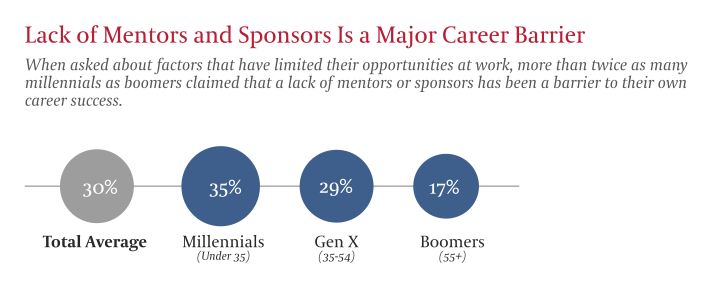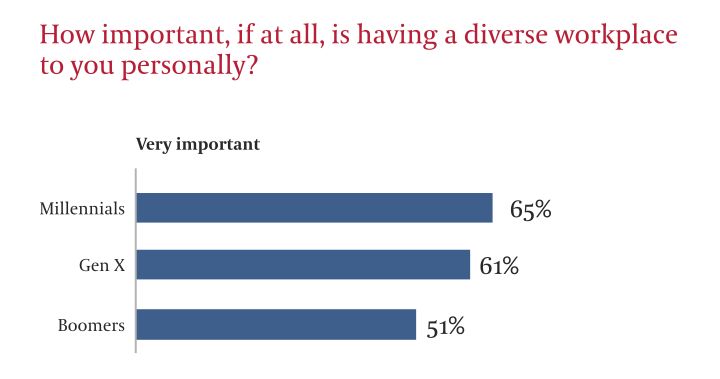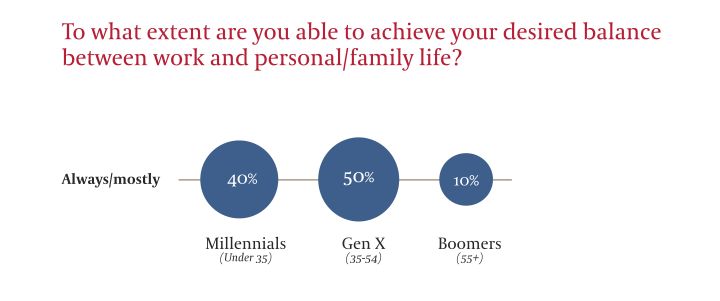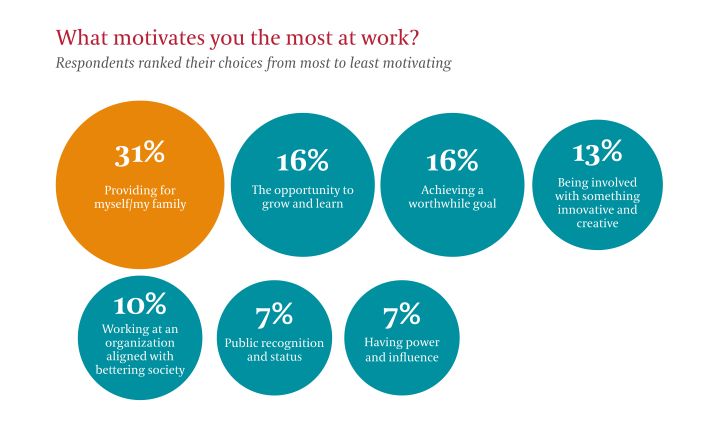2019 marks the fifth anniversary of Egon Zehnder’s Leaders & Daughters initiative. It’s been five years of meaningful conversations and connecting generations to build a stronger and more inclusive workforce. Five years of seeking solutions and actions that women and men can take to boost diversity and inclusion within an organization. And five years of encouraging young women to dream bigger and
promoting support of this ambition from older generations.
Through our 100 Leaders & Daughters events around the world, we’ve reached more than 6,000 people since the start of the initiative. We’ve heard moving stories of women and men working together to create a better world for their daughters and mentees, and we are seeing heartening changes being made in workplace policies and in unwritten responsibilities in the home. But our work together is not yet done. As a younger generation of leaders emerges in the workplace, they are poised to challenge the status quo — in success, in leadership and in diversity and inclusion.
In January 2019, we sought to find out just how differently genders and generations view these critical leadership topics. We surveyed 2,500 women and men with a range of leadership experience across seven countries — Australia, Brazil, China, Germany, India, the United Kingdom and the United States. We asked them how they defined great leadership, the importance of a diverse organization and how they prioritize and balance their professional and personal lives. The findings challenged traditional assumptions by showing that when it comes to leadership, we are much more closely aligned than most would believe. Men and women often had similar views, with greater distinctions between generations, geographies and experience levels. The generational findings also underscored the growing need for businesses to adapt to the changing professional and personal priorities of younger leaders.
Our survey influenced the questions and topics we focused on at many of our Leaders & Daughters events this year. What you will read in this report captures some of the insights and solutions from our over 30 events around the world in 2019. We hope you discover actions you can employ in your organization and your own life.
Making Mentorship Work
Mentorship came up in nearly every global conversation we had about helping women advance at work. A lack of mentors also was identified as a significant career barrier in our 2019 Leaders & Daughters Global Survey and was acutely felt by younger generations.

This need for mentorship builds on a resonant theme from 2018’s events — sponsorship. While both sponsorship and mentorship are important, they are not synonymous. Sponsorship focuses on creating opportunities for individuals and advocating for that person. Mentorship is more focused on advice and support. Sometimes these lines blur, but what matters most is that connections are being made to help someone achieve a goal. One of the key takeaways from the Johannesburg event was that women need a support system that includes both internal and external sponsors and mentors to enable them to thrive.
But what does the term “mentor” actually mean? People are constantly told they should have one or want one, but what does this relationship look like and how do you find a mentor? One of the themes from our Leaders & Daughters events series is that mentorship can take on many forms, from formal to casual and long and short term.
Some mentorships are more formal with clear cut expectations. At the Miami Leaders & Daughters event, Shana Henry, global reflections project coordinator at Bacardi, explained that she actively sought out her mentor, Marlene Gordon, senior vice president, general counsel and corporate secretary, of Fresh Del Monte Produce Inc. Henry was working as a teacher and an event planner, and her photographer husband had been working an event where he took photos for Gordon. He suggested Gordon as a potential mentor to his wife. “I stalked her on LinkedIn and reached out and stutteringly asked, ‘Can you be my mentor?’ and Marlene sent back an email with a contract,” Henry recounted. The contract outlined what the mentorship would look like — the two of them would create goals and regularly talk and meet. If Henry accepted the terms of the contract, then Gordon would be her mentor. “She was serious, and I shared my goals, signed and sent the contract,” Henry said. “And she stuck to it.”
In addition to being able to clearly define the expectations and goals of a relationship, formal mentoring also offers the advantage of being able to track the outcomes of mentorships. Did this relationship help someone achieve their goals? What could we learn from this experience to improve the program? It’s difficult to prove the success rate of anything without a track record.
“Measuring it and putting mentorship into a system is very important. As is going down into the organization and openly trying to encourage aspirational behavior or visibility.”
Sir Damon Buffini, Former Chairman and Managing Partner of Permira; Non-executive Director of Schroders
At the Istanbul event, Derin Ateş Öğüt, a high school student, pointed to her mother (Sanem Oktar, Chair of KAGIDER) as an advisor. “Thanks to my mother’s parenting style and the hard-working inspirational leader I get to see as I grow up, I learned to stand on my own feet, raise my voice when needed and solve my own problems without leaning on someone else,” she explained. “The fact that she was working very hard and making an impact in the world showed me that all of the hard work eventually pays off, not only financially but also spiritually.”
Our Take
-
Be a mentor and a mentee simultaneously. There is much we can learn from each other. Whether it is an intergenerational skills set exchange, a different world perspective or unbiased feedback, we all have something that is worthwhile to share. You may be in the midst of seeking a mentor, but you should also be offering your thoughts and expertise to someone else.
-
Don’t let fear get in the way. Too often we make excuses or are intimidated to ask someone for what we view as a favor. In fact, most would-be mentors would be flattered to be asked and already have an interest in helping others succeed. If someone says no, then simply seek out someone who is able to be an active contributor to your career advancement. Younger generations can also act as mentors to more experienced leaders.
Diversity and Inclusion: Focusing on the “I”
Many workplaces have been making strides with their diversity and inclusion (D&I) programs, as the approach has grown in importance with employees. This is supported by data from our Leaders & Daughters survey.

Male boomers in particular were not as focused on the value of diversity in the workplace, with nearly a quarter (23%) saying it was not important to them. Geographically, a diverse and inclusive workplace was more important to respondents in China (78 percent said it was very important) compared to those in Germany (44 percent said it was very important).
While diversity and inclusion go hand-in-hand, there is often a greater focus on diversity, with the assumption that the inclusion piece will occur organically once an organization has a broader range of talent. However, companies must make sure that their culture allows diverse talent to flourish and have a true impact on the organization. Inclusion is about involvement and empowerment —taking those diverse voices and giving them an opportunity to act. One of the related themes that surfaced at the San Francisco Leaders & Daughters event was “transformative resistance,” where individuals refuse to adopt an accepted behavior or approach that does not feel inclusive or respectful.
You can also use a lack of inclusion as a means for assessing your corporate culture. “You need to understand why women aren’t getting into leadership roles, and question if your senior leadership is cultivating the right environment,” said Gabi Carvalho, head of the Global Retail Financial Services Practice at Egon Zehnder.
"Younger generations feel more connected to diversity and inclusion."
Luis Giolo, Head of Egon Zehnder's Brazil Office
Another lens for examining inclusion is through diversity of thought and how accepted that is within a company. Our Leaders & Daughters Global Survey asked respondents if they believed their organizations valued diversity of thought, and 69 percent overall said they believed their companies genuinely believed in different ways of thinking and unique approaches to solving problems. “Different thoughts lead to innovation. Diverse people and opinions within an organization lead to better solutions,” said Fabio Coelho, CEO of Google Brazil, during the São Paulo event.
Our Take
-
Reshape your corporate culture. It’s not enough to simply hire diverse candidates; you must empower them to be able to speak up and be active contributors to your organization. That’s the reason you hired them in the first place — for new ways of thinking and doing things. But they must feel that they are able to share their thoughts and ideas. It’s also essential that your culture allows people to take calculated risks, make mistakes and sometimes fail. The failures are key to development and will help build employees into leaders, not just followers.
-
Use transformative resistance when necessary. Don’t assume someone else will speak up if a policy or an action doesn’t seem right. It’s every employee’s responsibility to retrain an organization to become more inclusive, which in turn, will better prepare the company for the future.
Striking the Balance Between Career and Personal Life
For all of the discussion surrounding achieving work/life balance, our survey suggested that many people are proactively finding a happy medium between personal and professional responsibilities.

However, in order for men and women to have a balance between their two worlds of work and home, they need support from their organizations, particularly when returning to work after starting a family, with a specific focus on men. It may sound counterintuitive, but a focus on allowing and encouraging men to be active parents will create more freedoms for women. “Companies need to allow or expect men to participate more: Encourage them to take their children to school or the doctor. Women should not be the only ones asking for permission to be absent from work,” was an insight heard at the Santiago Leaders & Daughters event.
In addition, men must be intentional when they are focusing on a family responsibility. “I deliberately made sure I was telling people I was going to football matches or whatever it was with my kids,” said Sir Damon Buffini, former chairman and managing partner of Permira and nonexecutive director of Schroders, at the London Leaders & Daughters event. “I felt I owed it to myself and to those in my organization to tell them they should have a life outside of work. I felt it was my responsibility to set the example.”
Even with a partner who is supportive at home, women still often feel that time is their biggest resource constraint. A panelist at the Mumbai Leaders & Daughters event suggested “ruthless outsourcing” as a potential solution. “Outsourcing may appear expensive now, but you’ll realize the returns later in life. Women also should not feel guilty for outsourcing —it’s building an ecosystem of support,” she said.
"What we need from men is to share the burden equally and for them to realize that making a life, supporting family – both financially and spiritually – is a collective business. Mutual support and effort put in will create a balance."
Sanem Oktar, Chair, KAGIDER
Our Take
-
Support women and men returning to the workforce. Embrace flexible work arrangements and ensure men and women are given equal opportunities to put their lives in balance. For example, offer parental leave instead of simply maternity leave. It spreads the responsibilities to all parents and not just mothers.
-
Be conscious of unconscious bias. Do not make assumptions about the roles and responsibilities of parents returning to work might want. Let him or her make the decision. For instance, do not assume a woman with a family won’t want to take on a project that involves travel. Give her the option to make her own decision, ensuring she is supported whatever her decision may be.
Striving for Passion and Purpose
In our Leaders & Daughters survey, we asked respondents to rank what their chief motivations for working were.

We saw this desire bear out in many Leaders & Daughters events where the notion of aligning passion and purpose was highlighted.
"For too long, women haven’t dared to dream because they were too afraid of the consequences it will have on their family lives. But today, the spotlight of her life is on her and she should get the opportunity to design it the way she likes.”
Leaders & Daughters, Mumbai
A daughter who spoke at the Leaders & Daughters event in China shared her hope that younger workers would seek out what will truly fulfil them in their careers. “Although working is very important, finding joy in your profession is more important than working itself,” she explained. “I hope young people can turn their interests into a career or focus more on their interests after becoming financially stable.”
At the Sydney Leaders & Daughters gathering, this same sentiment arose. “Ask yourself what you actually want to do, and what you would find meaningful,” a speaker at the event noted.
While there are notable implications for personal and family life when it comes to following a dream, the payoff —and the journey —may well be worth it
Our Take
-
Prepare yourself for the risks of change. If you are not passionate about your current work, you will likely need to make a transition to find it. Ask yourself what changes you would need to make to feel that passion and purpose. Do you need different skills sets or different subject-matter expertise? Make a roadmap for how you can make this transition and do not expect to make a large-scale career change overnight.
-
Reframe your career narrative. You may assume you are lacking purpose in your current position, but perhaps you need to think more holistically about the work you are doing. How does your role help the broader organization accomplish its goals? Can you find purpose in that vision?
We hope that you have enjoyed this summary of our Leaders & Daughters event series, and that you will help us empower a younger generation of leaders to create a better world for us all by participating in future events or by sharing your own experiences.
You can also be part of our To My Daughter campaign, a worldwide movement in which fathers, mothers and mentors write letters of guidance and wisdom to the important young women in their lives.
If you would like more information about Egon Zehnder’s Diversity and Inclusion practice, please contact one of our leaders:
For more information on the content of this report, please contact Cheryl.Martel@egonzehnder.com.





